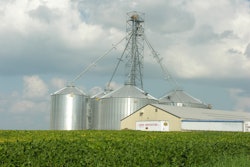Since 2008, the U.S. economy has remained generally grim as it’s teetered between periods of recession and slight uptick. Industries like manufacturing, construction and realty famously suffered, while others like technology and food weathered the storm less scathed. But one segment has consistently outperformed the rest throughout this tumultuous period in U.S. history: agriculture.
Given the strength of the industry, banks are eager to lend money to the grain segment, but according to sources at some of today’s leading ag lending institutions, they can’t find the demand. Many agriculture-related firms are taking cues from the rest of the country’s outlook and are holding on to their cash and putting off large financial moves like expansions or loan refinancing. While there’s nothing inherently wrong with keeping your liquid assets in check, bank execs argue that now may be the best time to revisit your long-range debt terms and invest some of the capital you’ve been holding onto.
Elizabeth Hund, senior vice president and division head of U.S. Bank Food Industries; Galen G. Herr, regional credit officer of Rabo Agrifinance; and Mitch Ferree, title of Regions Bank provided an update of today’s agriculture lending landscape and outlined how to best take advantage of current market conditions.
Feed & Grain: What are the general market conditions for agriculture today?
Mitch Ferree, Regions Bank:On a micro level, supplies are down after last year’s drought and the market is trying to determine if the current crop can refill some of the grain pipeline. Old crop corn and old crop beans still offer some real opportunities to sell because they're still at historically high levels, but the opportunity to price has not been nearly as lucrative, due to the expectation for a larger crop — which may or may not materialize.
Galen G. Herr, Rabo Agrifinance:The long-term outlook is positive for agriculture, due to the growing demand driven by population expansion and the developments of the Chinese and Indian economies. When the income of the people in those countries increases, it will lead to improvement in diets and greater demand for protein, which translates into greater demand for feed grain.
F&G:这个翻译成heighte前景乐观ned banking activity within the ag sector?
Ferree:With agriculture being as strong as it’s been over the last three or four years, the risk profile of ag borrowers has been very good, but loan demand has been light because operators have strengthened their liquidity positions and don't need to borrow. Many in this marketplace have little to no balances on the line because the markets have allowed them to strengthen their financial statements.
Elizabeth Hund, U.S. Bank Food Industries:We’ve got a real appetite for lending to the grain industry with little demand right now. From February 2008 to February 2013, [U.S. Bank’s] loan outstandings to grain companies was down approximately 30%. As a result, banks are willing to do longer tenures, larger loans, and give aggressive pricing because they don’t have enough assets on their books. If I were in the grain business, and even if I’d had a rough year, I would still be aggressive with the banks.
The banks have cleaned themselves up, are in good positions and have unloaded troubled assets, but the economy is slow so no one is growing, hiring, borrowing or expanding — and that’s the engine that feeds the banking industry.
F&G: Are banks reluctant to lend to the grain sector after last summer’s drought?
Herr:As an ag lender, we understand the production risks aspect and understand that you can have a bad year, but if you have good management and good fundamentals, you're going to be able to rebound following a bad year.
Overall, the grain origination sector has been very stable and a widespread weather event is fairly unusual. The last time we had a drought of this magnitude was 1988, and the following year crop yields were close to trend line. We are looking for business with ag companies that have sound solvency, sound net worth, have a strong working capital position and have had a history of profitable operations during the good times. Those are the types of companies that are going to be able to weather the bad year or the short crop year.
F&G: What is your message to those on the fence about expanding orinvesting in business growth?
Ferree:I would want them to understand their position very well. For any kind of expansion, make sure you're putting a good business plan behind that decision. Anytime you make long-term capital purchases, it is just that — a long-term investment — and you want to make sure you are willing to take on the risks associated with that investment before depleting your liquid position.
Every operator situation is a little bit different and you've got to have a good handle on what those expansions are going to do for the operation over time. Expansion just for the sake of expansion doesn't do anybody any good; there's got to be a business case around it to help them make plans for a future generation or an income opportunity.
Herr:First, be diligent about doing a cost-benefit analysis of the opportunity to look at the financial risks, as well as the operating risks that may be associated with any type of growth or expansion. Then, bring your lender in at an early stage to get financial feedback on these opportunities and to benefit from the experience they’ve had in similar situations with other clients. Rely on lenders or other professionals as value added resources to make sure whatever business risk you’re taking with a new line or an expansion is well thought out and has a high probability of success.
Hund:Many companies are hesitant over the uncertainty of tax rates, Obamacare and the threat of a Chinese recession, but you’re never going to get cheaper money than right now. If you’re considering a long-term investment — three to 10 years —the interest rates can’t go down much further, so I’d say, ‘Do it.’
You’re not going to find a better time to borrow. In the 33 years since I started, the industry has never been more bullish. There are a lot of reasons to be conservative, but there’s also the fact that the time is right if you take a global focus.
F&G: What advice do you have for those who are not in the best financial position but are eager to borrow?
Ferree:My advice to the grain elevators is to let their banker know exactly what the situation is and the cause of the need for additional capital. If it is because of a poor decision in the past, then have a plan in terms of how you're going avoid that situation going forward.
One good thing from an elevator’s perspective is the markets have stabilized somewhat, so there's not quite as much dramatic switch up and down, which can put an elevator in a precarious position. If Mother Nature works right in terms of having a good crop, I'd say we could see some downside in this market, which would alleviate some capital needs. But, the key to any banker-borrower relationship is good communication. Banks want to understand what’s driving the issues you may have and the need for capital, and what you're going to do to help offset risk.
Hund:Banks want grain companies to be very liquid and have enough money to meet a market call anytime the market moves, which is daily. We don’t want them to be highly leveraged and they shouldn’t have a lot of long-term debt on their balance sheet because if there is a bad year and you don’t generate the cash flow you usually do, that’s going to be a problem.
I like to say: ‘You can’t control the weather, but you can manage your balance sheet.’ If you have long-term debt on your balance sheet that you need to service, the interest rates aren’t going to get any cheaper so do what you can to refinance the debt. If the pre-payment is too high, it may not make financial sense, but if you can refinance, this is a great time to refinance.






















